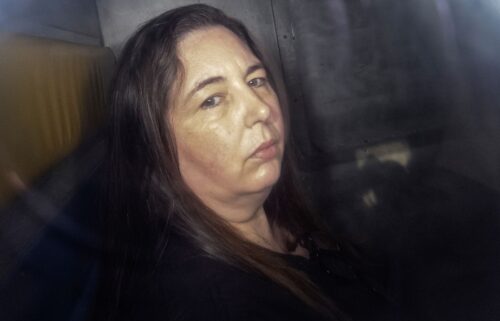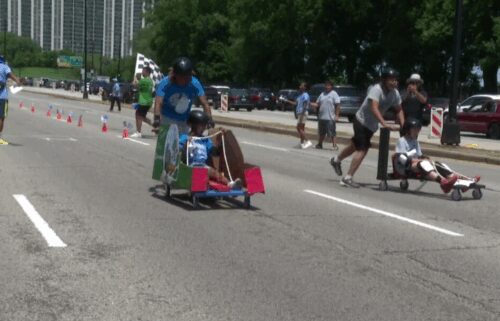Medical student invents negative-pressure helmet to treat virus-stricken patients

Click here for updates on this story
Toledo, OH (Toledo Blade) — It was early March of 2020.
The coronavirus pandemic was intensifying throughout the United States when Shalini Kota took a trip to Ann Arbor to visit her parents.
When she sat down for dinner with them, her father, Sridhar Kota, a University of Michigan professor of mechanical engineering, began discussing an email he had received from Michigan Medicine doctors hoping to better isolate the virus.
More patients would soon need treatment.
The father and daughter brainstormed about negative-pressure rooms, a concept that has existed since 1980. It became more important when thinking about how to house and treat patients with highly infectious diseases.
“I’m an engineering professor, I did not know anything about negative-pressure rooms,” said Mr. Kota, who served as the assistant director for advanced manufacturing at the White House Office of Science and Technology Policy from 2009 to 2012.
But his daughter, Ms. Kota, a second-year University of Toledo medical student, had.
The two discussed how such rooms can keep infectious diseases confined within them and, thus, reduce the potential for spread to patients in nearby rooms.
Patients with infectious diseases require constant medical attention, and health-care workers go in and out of their rooms.
“It’s almost as if we were putting [personal protective equipment] on the wrong people,” Ms. Kota said. “So if you could sort of prevent the virus from spreading even within a room, that would have significant benefit to mitigating the spread of the virus for everyone.”
Then, Ms. Kota recalled, she looked at a greeting card she had received that had an astronaut helmet drawn on the front.
A light bulb went off in her head.
“It really sparked this idea of ‘What if, in addition to putting PPE on health-care workers, we tried to go a little bit upstream, and mitigate virus spread through [patients themselves]?’” she said.
Thus, the Aerosolve Helmet, a personal negative-pressure room of sorts, was born.
The next day, Mr. Kota presented the idea to Dr. Kevin Ward, a U-M professor of emergency medicine and biomedical engineering.
Two days later, a prototype was built. And within days of that, the helmet was authorized to be used on patients under an innovative care protocol at Michigan Medicine.
“He said, ‘Wow, that should work,’” Mr. Kota said, “and I was shocked. I thought he would say, ‘Yeah, we tried that, that doesn’t work.’”
Worn by the patient, the Aerosolve helmet captures exhaled breath, drawing it through a vacuum and a high-efficiency particulate air filter that sucks away the infected patient’s aerosols.
Dozens of hospitals began asking about the device.
A team of researchers, doctors, and engineers founded a startup company, Inspire Rx LLC, to make it.
They hope to get emergency use authorization from the U.S Food and Drug Administration soon.
The helmet is also useful for transporting patients who have infectious diseases such as coronaviruses, Mr. Kota said.
“When a patient suspected of COVID enters an ambulance, what are you doing right now?” he asked, adding that transporting a very sick patient in an ambulance or a helicopter exposes paramedics and others treating that patient, even if they wear personal-protective equipment.
The team took the idea further and created a negative-pressure tent in addition to the helmet.
Ms. Kota, who’s credited as the helmet’s co-founder, also co-wrote three journal articles and came up with the name Aerosolve. She said being around her father has often inspired her to think of solutions to problems.
“My Dad is a mechanical engineer and an inventor, and that’s something we share,” Ms. Kota said. “We have a lot of ideas. And there are some that certainly take off, and you kind of sit on them. With this one, we thought it was almost too simple…. I think we were both kind of surprised that it hadn’t been tried before.”
Testimonials from medical professionals praise the invention as an innovative tool that will help treat infectious diseases beyond coronaviruses.
Seth Krupp, Henry Ford Health System medical director and vice chairman of emergency medicine operations, said Aerosolve “will solve a significant safety and operational concern for our patients and employees.”
“By using the portable negative airflow respiratory filters, our ability to provide this care will be greatly increased without the risk of moving patients in and out of negative-pressure rooms, which are a limited resource,” he wrote.
“The Aerosolve tent provides a safer working environment for staff, given the limited number of negative-pressure rooms,” Dr. Michael Thomas, Michigan Medicine cardiac critical care unit medical director, said.
Mr. Kota said his daughter has always been innovative, and this particular idea began with just a 15-minute conversation.
“She’s always been very creative,” he said. “It doesn’t surprise me she thinks of stuff like that. As a kid, she had all kinds of inventions before she even knew how to spell invention. I’m very proud of her.”
Ms. Kota said she’s optimistic the device will soon get FDA approval.
She hopes the helmet becomes a standard in health-care centers across the United States.
“I have great pride in the teamwork that went into creation and innovation for this device,” the 26-year-old said. “The goal was always that while we’re sitting at home during this pandemic, that we can help as many people as possible now and in the future.”
Please note: This content carries a strict local market embargo. If you share the same market as the contributor of this article, you may not use it on any platform.



